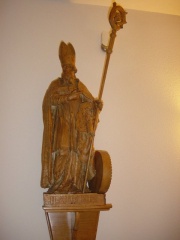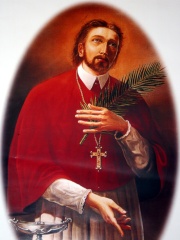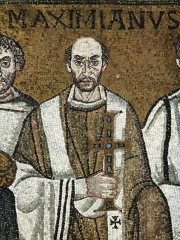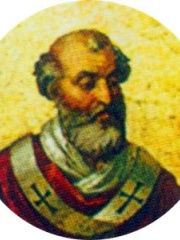
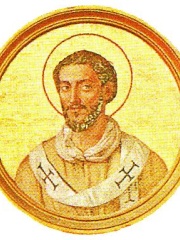
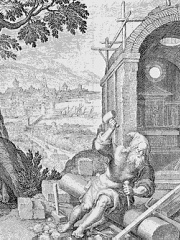
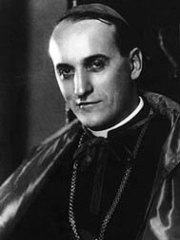
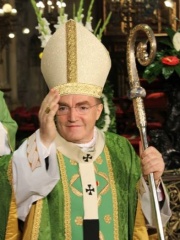
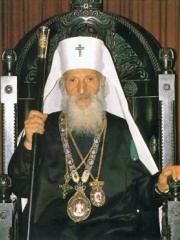
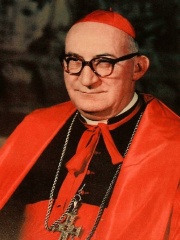
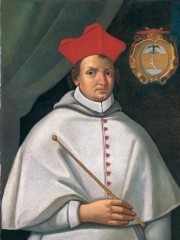
The Most Famous
RELIGIOUS FIGURES from Croatia
This page contains a list of the greatest Croatian Religious Figures. The pantheon dataset contains 3,187 Religious Figures, 17 of which were born in Croatia. This makes Croatia the birth place of the 32nd most number of Religious Figures behind Brazil, and Mexico.
Top 10
The following people are considered by Pantheon to be the top 10 most legendary Croatian Religious Figures of all time. This list of famous Croatian Religious Figures is sorted by HPI (Historical Popularity Index), a metric that aggregates information on a biography's online popularity. Visit the rankings page to view the entire list of Croatian Religious Figures.

1. Pope John IV (600 - 642)
With an HPI of 74.28, Pope John IV is the most famous Croatian Religious Figure. His biography has been translated into 72 different languages on wikipedia.
Pope John IV (Latin: Ioannes IV; died 12 October 642) was the bishop of Rome from 24 December 640 to his death on 12 October 642. His election followed a four-month vacancy. He wrote to the clergy of Ireland and Scotland to tell them of the mistakes they were making with regard to the time of keeping Easter and condemned Monothelitism as heresy. According to sacred tradition, he created the Catholic Church in Croatia with Abbot Martin.

2. Pope Caius (250 - 296)
With an HPI of 73.34, Pope Caius is the 2nd most famous Croatian Religious Figure. His biography has been translated into 74 different languages.
Pope Caius (died 22 April 296), also called Gaius, was the bishop of Rome from 17 December 283 to his death in 296. Little information on Caius is available except that given by the Liber Pontificalis, which relies on a legendary account of the martyrdom of Susanna of Rome for its information. According to legend, Caius baptized the men and women who had been converted by Tiburtius (who is venerated with Susanna) and Castulus. His legend states that Caius took refuge in the catacombs of Rome and died a martyr.

3. Saint Marinus (275 - 366)
With an HPI of 73.29, Saint Marinus is the 3rd most famous Croatian Religious Figure. His biography has been translated into 38 different languages.
Marinus (; Italian: San Marino) is a Christian saint, who according to hagiographical accounts recorded centuries after his lifetime was the founder of a chapel and monastery in 301 from whose initial community the state of San Marino later grew.

4. Aloysius Stepinac (1898 - 1960)
With an HPI of 70.51, Aloysius Stepinac is the 4th most famous Croatian Religious Figure. His biography has been translated into 33 different languages.
Aloysius Viktor Stepinac (Croatian: Alojzije Viktor Stepinac, 8 May 1898 – 10 February 1960) was a Croat prelate of the Catholic Church. Made a cardinal in 1953, Stepinac served as Archbishop of Zagreb from 1937 until his death. He served during the Kingdom of Yugoslavia, as well as during World War II when the Axis-supported Croatian fascist Ustaše regime ruled the Independent State of Croatia (NDH). Following the war, he was tried by the communist Yugoslav government and convicted of treason and collaboration with the Ustaše regime. The trial was depicted in the West as a typical communist "show trial", and was described by The New York Times as biased against Stepinac. However, John Van Antwerp Fine Jr. was of the opinion that the trial was "carried out with proper legal procedure". In a verdict that polarized public opinion both in Yugoslavia and beyond, the Yugoslav authorities found him guilty on the charge of high treason (for collaboration with the Ustaše), as well as complicity in the forced conversions of Orthodox Serbs to Catholicism. Stepinac advised individual priests to admit Orthodox believers to the Catholic Church if their lives were in danger, such that this conversion had no validity, allowing them to return to their faith once the danger passed. Jozo Tomasevich notes that Stepinac and the Church were "willing to cooperate with the regime's forced conversions, provided the canonical rules were followed", when in fact the Ustaše ignored these rules, committing atrocities, including the mass killing of converts. Stepinac was sentenced to 16 years in prison, but served only five at Lepoglava before being released, with his movements confined to his home district of Krašić. In 1953 he was elevated to the rank of cardinal by Pope Pius XII. He was unable to participate in the 1958 conclave due to government restrictions on his travel. On 10 February 1960, still confined to Krašić, Stepinac died of polycythemia, for which he had been receiving treatment for a number of years. On 3 October 1998, Pope John Paul II declared him a martyr and beatified him before 500,000 Croatians in Marija Bistrica near Zagreb. His record during World War II, conviction for treason, and subsequent beatification remain controversial. Some point to Stepinac's efforts to save individual Jews, while others note that his public support of the Nazi-puppet NDH gave it legitimacy, helping the Ustaše maintain power and commit genocides against Jews, Serbs and Roma. Criticism has also been levelled for Stepinac's failure to speak out publicly against the genocide of the Serbs, against forced conversions and the killing of 157 Orthodox priests and 5 bishops, among other Ustaše crimes against Serbs. On 22 July 2016, the Zagreb County Court annulled his post-war conviction due to "gross violations of current and former fundamental principles of substantive and procedural criminal law". Pope Francis invited Serbian prelates to participate in canonization investigations, but in 2017 a joint commission was only able to agree that "[i]n the case of Cardinal Stepinac, the interpretations that were predominantly given by Catholic Croats and Orthodox Serbs remain divergent".
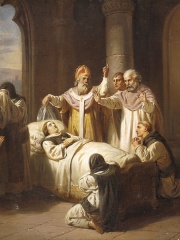
5. Margaret of Hungary (1242 - 1270)
With an HPI of 68.48, Margaret of Hungary is the 5th most famous Croatian Religious Figure. Her biography has been translated into 30 different languages.
Margaret of Hungary, OP (Margit in Hungarian; 27 January 1242 – 18 January 1270) was a Dominican nun and the daughter of King Béla IV of Hungary and Maria Laskarina. She was the younger sister of Kinga of Poland (Kunegunda) and Yolanda of Poland and, through her father, the niece of the famed Elizabeth of Hungary.

6. Josip Bozanić (b. 1949)
With an HPI of 66.04, Josip Bozanić is the 6th most famous Croatian Religious Figure. His biography has been translated into 28 different languages.
Josip Bozanić (pronounced [jǒsip bǒzanit͡ɕ]; born 20 March 1949) is a Croatian prelate of the Catholic Church who was the Archbishop of Zagreb from 1997 to 2023. He was previously Bishop of Krk from 1989 to 1997. He was made a cardinal in 2003. Bozanić is the Grand Prior of the Croatian Lieutenancy of the Equestrian Order of the Holy Sepulchre of Jerusalem.

7. Pavle, Serbian Patriarch (1914 - 2009)
With an HPI of 63.59, Pavle, Serbian Patriarch is the 7th most famous Croatian Religious Figure. His biography has been translated into 26 different languages.
Patriarch Pavle (Serbian Cyrillic: Патријарх Павле, Patriarch Paul; secular name: Gojko Stojčević, Serbian Cyrillic: Гојко Сточевић; 11 September 1914 – 15 November 2009) was the Patriarch of the Serbian Orthodox Church from 1990 to his death. His full title was: His Holiness the Archbishop of Peć, Metropolitan of Belgrade and Karlovci, and Serbian Patriarch Pavle. Before his death, he was the oldest living leader of an Eastern Orthodox church. Because of poor health, he spent his last years in the Military Medical Academy in Belgrade, while his duties were carried out by Metropolitan Amfilohije (Radović) of Montenegro and the Littoral.

8. Franjo Šeper (1905 - 1981)
With an HPI of 63.59, Franjo Šeper is the 8th most famous Croatian Religious Figure. His biography has been translated into 20 different languages.
Franjo Šeper (2 October 1905 – 30 December 1981) was a Croatian prelate of the Catholic Church. He served as prefect of the Congregation for the Doctrine of the Faith from 1968 to 1981, and was elevated to the cardinalate in 1965. Before that, he served as the Archbishop of Zagreb from 1960 to 1969.

9. George Martinuzzi (1482 - 1551)
With an HPI of 62.96, George Martinuzzi is the 9th most famous Croatian Religious Figure. His biography has been translated into 20 different languages.
George Martinuzzi, O.S.P.P.E. (born Juraj Utješenović, also known as György Martinuzzi, Brother György, Georg Utiessenovicz-Martinuzzi or György Fráter, Hungarian: Fráter György; 1482 – 16 December 1551), was a Croatian nobleman, Pauline monk and Hungarian statesman who supported King John Zápolya and his son, King John Sigismund Zápolya. He was Bishop of Nagyvárad (now Oradea), Archbishop of Esztergom and a cardinal.
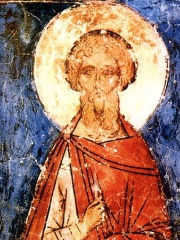
10. Julian of Antioch (231 - 305)
With an HPI of 62.94, Julian of Antioch is the 10th most famous Croatian Religious Figure. His biography has been translated into 15 different languages.
Julian of Antioch (Latin: Julianus, Greek: Ίουλιανός; d. AD 305 x 311), variously distinguished as Julian the Martyr, Julian of Tarsus, Julian of Cilicia, and Julian of Anazarbus, was a 4th-century Christian martyr and saint. He is sometimes confused with the St Julian who was martyred with his wife Basilissa.
People
Pantheon has 17 people classified as Croatian religious figures born between 231 and 1949. Of these 17, 1 (5.88%) of them are still alive today. The most famous living Croatian religious figures include Josip Bozanić. The most famous deceased Croatian religious figures include Pope John IV, Pope Caius, and Saint Marinus.
Living Croatian Religious Figures
Go to all RankingsDeceased Croatian Religious Figures
Go to all RankingsPope John IV
600 - 642
HPI: 74.28
Pope Caius
250 - 296
HPI: 73.34
Saint Marinus
275 - 366
HPI: 73.29
Aloysius Stepinac
1898 - 1960
HPI: 70.51
Margaret of Hungary
1242 - 1270
HPI: 68.48
Pavle, Serbian Patriarch
1914 - 2009
HPI: 63.59
Franjo Šeper
1905 - 1981
HPI: 63.59
George Martinuzzi
1482 - 1551
HPI: 62.96
Julian of Antioch
231 - 305
HPI: 62.94
Quirinus of Sescia
300 - 309
HPI: 62.03
Marko Krizin
1589 - 1619
HPI: 61.84
Maximianus of Ravenna
499 - 556
HPI: 61.66
Overlapping Lives
Which Religious Figures were alive at the same time? This visualization shows the lifespans of the 4 most globally memorable Religious Figures since 1700.

